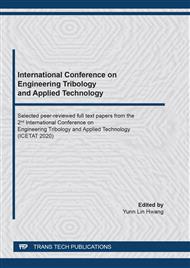p.1
p.7
p.13
p.19
p.27
p.33
p.39
p.47
The Structural Material Property Analysis of CNC Machine Tools Based on Tribology Applied Method
Abstract:
Tribology applied method (TAM) is a method to investigate the interacting surface in relative motion includes the principles of friction, lubrication, and wear. The main objective of this study is to investigate the effect of structural material property on Multi-body dynamic. The stick-slip friction (SSF) and the contact normal force is used as influence of machine tools in numerical simulation. The numerical simulation is conducted on three axes CNC machine without friction, with sliding friction and with SFF to find out the effect of the influence parameter. The PID controller is used as the compensation in the numerical simulation. The result show that the unsmooth motion of CNC machine due the friction will affect the accuracy and the performance of the CNC machine.
Info:
Periodical:
Pages:
13-18
Citation:
Online since:
November 2021
Authors:
Keywords:
Price:
Сopyright:
© 2021 Trans Tech Publications Ltd. All Rights Reserved
Share:
Citation:


